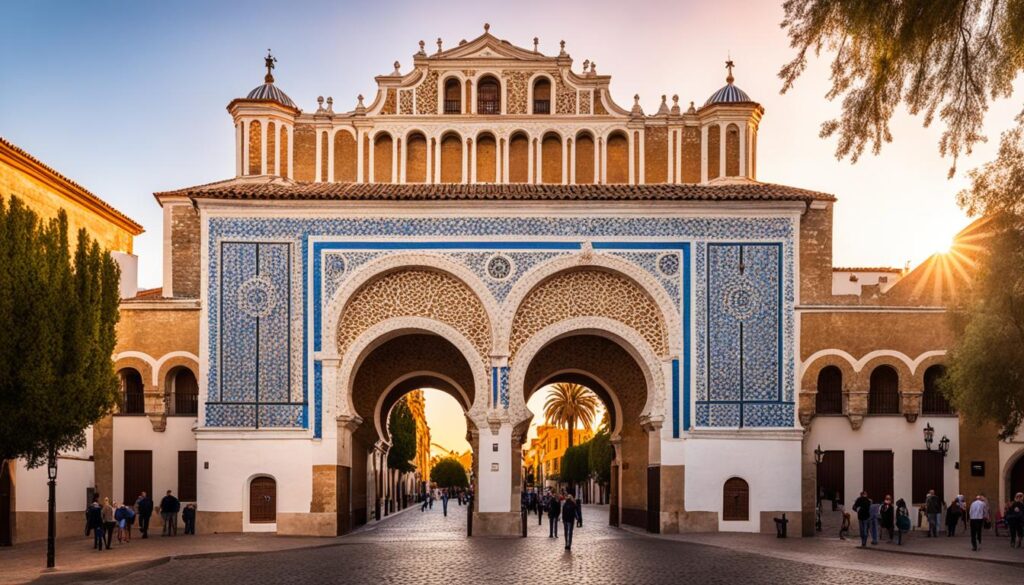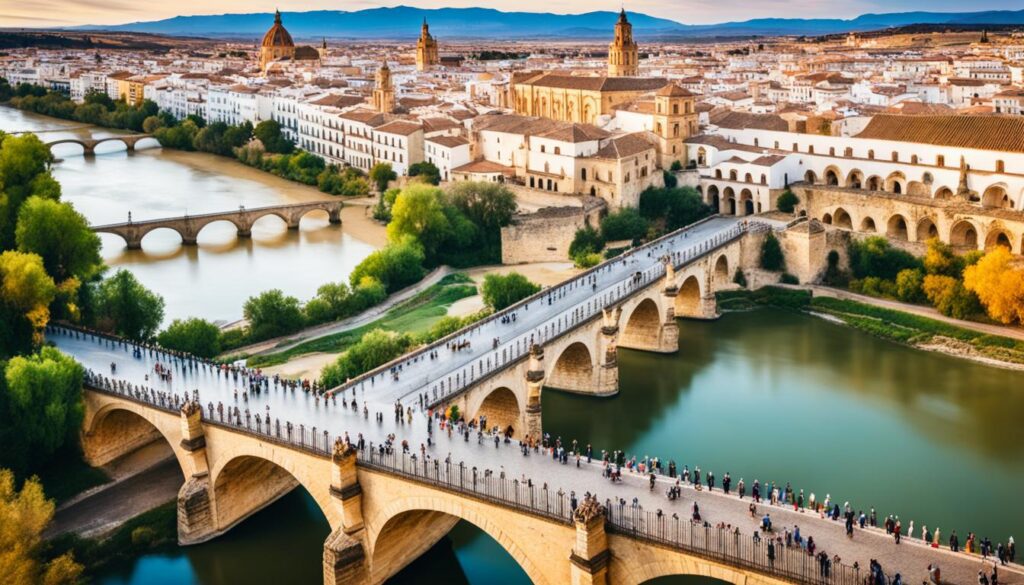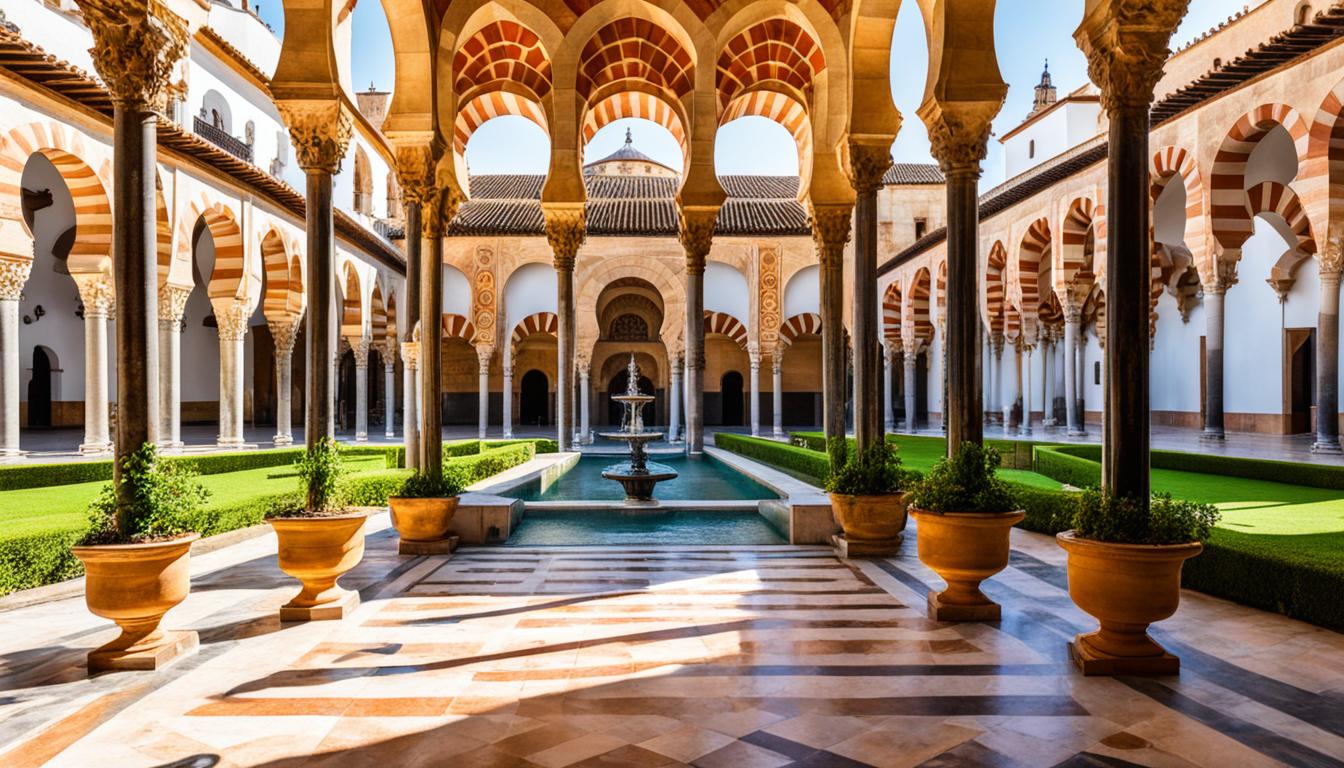Cordoba sits in the heart of Andalusia, calling out to travelers from across the globe. It’s a city with a deep cultural history, home to four UNESCO World Heritage Sites. This is more than what Rome or Paris can claim.
Visitors can marvel at the Mezquita-Catedral and the Alcazar de los Reyes Cristianos. These sites are just the start of what makes Cordoba a must-see destination.
Getting to Cordoba from Seville is easy, taking about 1.5 hours by car or 45 minutes by train. You can wander through the Judería, admire Moorish architecture, or try the famous tapas and Cordoban dishes. Cordoba is a city that will leave you enchanted and eager to return.
Key Takeaways
- Cordoba boasts 4 UNESCO World Heritage Sites, more than Rome or Paris
- Explore the iconic Mezquita-Catedral, a stunning example of Moorish architecture
- Discover the Alcazar de los Reyes Cristianos, a historical palace and garden complex
- Wander through the captivating Judería, the city’s charming Jewish Quarter
- Indulge in Cordoba’s renowned tapas and authentic Andalusian cuisine
Uncover the Mesmerizing Mezquita – Mosque-Cathedral
In the heart of Cordoba, the Mezquita-Catedral stands out. It’s a mix of Moorish and Christian styles. Built as a mosque in the 8th century, it became a cathedral in the 13th century after the Christian takeover.
Explore the Moorish Architecture and Christian Influences
Walking into the Mezquita-Catedral, you’ll see its Moorish beauty. It has red and white striped arches and detailed designs. The size is huge, covering 24,000 square meters, with 856 columns holding up the arches.
But it’s not just Moorish. The cathedral also shows Christian touches. The main nave and choir stalls mix Gothic and Renaissance styles well with the Moorish design.
Join a Guided Tour for an Enriching Experience
A guided tour is a great way to learn about the Mezquita-Catedral. Guides share stories of its history and the mix of Moorish and Christian styles. This makes the tour very informative.
If you love history, architecture, or Cordoba’s culture, don’t miss this place. The Mezquita-Catedral will amaze you with its mix of Moorish and Christian art.
Marvel at the Alcazar de Los Reyes Cristianos
Close to the famous Mezquita-Catedral, you’ll find the Alcazar de Los Reyes Cristianos, or the Palace of the Christian Kings. This 14th-century fortress was a royal home. It’s now one of Cordoba’s UNESCO World Heritage Sites, showing off the city’s history and architecture.
Walking into the Alcazar, you’ll see a mix of Moorish, Gothic, and Renaissance styles. The palace looks amazing, with detailed carvings and beautiful designs. It shows the area’s rich culture.
Inside, you can see 4th-century Roman frescoes that are still in great shape. Go up the tower for amazing views of Cordoba. You’ll see the Mezquita-Catedral and the Guadalquivir River.
The gardens at the Alcazar are peaceful and beautiful. They have colorful flowers, orange trees, and fountains. It’s a perfect place to relax, whether you love history, architecture, or just pretty spots.
“The Alcazar de Los Reyes Cristianos is a true architectural gem, seamlessly blending Moorish, Gothic, and Renaissance influences to create a truly captivating and historically significant landmark.”
For a deeper experience, take a guided tour of the Alcazar. It’s a great way to learn about its history and cultural stories. The Alcazar de Los Reyes Cristianos is a top spot in Cordoba, known for its beauty and history.
https://www.youtube.com/watch?v=WsSqElw6wd8
Wander Through the Captivating La Juderia
Explore the charm and history of Cordoba’s old Jewish Quarter, La Juderia. It’s a UNESCO World Heritage Site known for its narrow, white streets. Here, you’ll find shops, restaurants, and historic spots. Enjoy the local culture by trying authentic tapas and Cordoban cuisine at the bars.
Discover the Jewish Quarter and Its Historic Sights
Walk through La Juderia’s winding alleys to see its Jewish heritage. You’ll see the Cordoba Synagogue, a beautiful example of Mudejar architecture. It’s the only synagogue left in Andalusia. Then, visit the Casa Sefarad-Israel, a museum about Sephardic Jews.
Don’t miss the Plazuela de Tiberiades. It has a statue of Maimonides, a famous philosopher and doctor from Cordoba.
Enjoy Authentic Tapas Bars and Cordoban Cuisine
Experience the local culture at La Juderia’s tapas bars and restaurants. Try the creamy salmorejo soup and the flavorful rabo de toro stew. Enjoy local wines and feel the famous Cordoban hospitality.
“Wandering through the narrow streets of La Juderia, you can almost feel the echoes of Cordoba’s rich Jewish heritage. It’s a truly captivating and historical experience.”
Capture the Beauty of the Almodovar Gate
No visit to Cordoba is complete without seeing the Almodovar Gate. It’s the city’s best-preserved Moorish architecture and historic city gates. Built in the 14th century, it was part of Cordoba’s defensive walls. Now, it’s the main entry into the historic La Juderia neighborhood.
The Almodovar Gate is a true architectural gem. It shows off the beautiful Moorish architecture that shaped Cordoba. Visitors can see the detailed designs, arched entryways, and striking towers. These features make the landmark stand out.
As you go through the gate, you’ll feel like you’ve stepped back in time. You’ll sense the deep history and cultural importance of Cordoba.

Exploring the narrow streets of La Juderia or just taking in the views, the Almodovar Gate is a must-see. Its timeless beauty and historical significance highlight any trip to Cordoba. Make sure to capture the essence of this iconic Moorish architecture and historic city gates during your visit.
best things to do in Cordoba Spain
Just 5 miles west of Cordoba, Medina Azahara is a key site. It shows the grandeur of the Moorish civilization in Spain. Built in the 10th century, it was the capital of the Moorish kingdom of Al-Andalus under Caliph Abd-ar-Rahman III.
Uncover the Ruins of a Forgotten Civilization
Medina Azahara, known as the “Caliphate City,” was destroyed after 70 years. It was forgotten for centuries. Now, its ruins are a UNESCO World Heritage site, showing the Moors’ architectural and cultural achievements.
Walking through, you’ll feel like you’re stepping back in time. You’ll see the remains of a civilization that once was. This is your chance to dive deep into Medina Azahara Cordoba history.
The Caliphate City was a marvel of engineering and design. It had palaces, mosques, and buildings over a vast, planned area. At the archaeological site Cordoba, you’ll see the grandeur and sophistication of this Cordoba UNESCO sites center of power.
“Medina Azahara was a remarkable feat of engineering and design, with a complex of palaces, mosques, and administrative buildings spread across a vast, well-planned layout.”
Make sure to visit this Caliphate City to learn about its history and legacy. Medina Azahara is a key spot for anyone interested in Cordoba’s Moorish heritage and the civilization that once thrived here.
Admire the Picturesque Calleja de las Flores
In the heart of Cordoba’s historic center lies the Calleja de las Flores, or Flower Street. It’s a gem that enchants everyone who walks its charming alleys. This famous alley is filled with colorful flowerpots and plants. It’s a top spot for photos and draws visitors from all over.
Spring is the best time to see the Calleja de las Flores. The flowers bloom fully, showing off a stunning array of colors and scents. It’s best to visit early in the morning or late afternoon to beat the crowds. This way, you can also see the Mezquita-Cathedral’s bell tower beautifully.
Walking through the Calleja de las Flores is a must for Cordoba visitors. It shows off the city’s history and its long-standing love for flowers. The Fiesta De Los Patios festival, held yearly, makes the alley even more special. It highlights the beautiful patios and courtyards, with their stunning flowers.
Seeing the Calleja de las Flores doesn’t cost anything. It’s a peaceful spot away from the city’s noise. Whether you love photography or just want to enjoy Cordoba’s beauty, this place will touch your heart and mind deeply.
“The Calleja de las Flores is a true feast for the senses, a captivating display of color, fragrance, and architectural splendor that perfectly encapsulates the essence of Cordoba.”
Photograph the Iconic Puerta del Puente
The Puerta del Puente, or Bridge Gate, is a key landmark in Cordoba. It was rebuilt in the late 16th century. It replaced an earlier Moorish and Roman gateway. Located at the end of the historic Roman bridge, it’s perfect for capturing Cordoba’s mix of Roman and Moorish architecture.
Looking through the archway of the Puerta del Puente gives a great view of the Roman bridge. The gateway’s detailed stonework and the arches make a beautiful scene. This spot is loved by both locals and visitors.
| Landmark | Description |
|---|---|
| Puerta del Puente | The Puerta del Puente, or Bridge Gate, was rebuilt in the late 16th century to replace an earlier Moorish and Roman gateway. It offers a prime spot to photograph the blend of Roman and Moorish architecture in Cordoba. |
| Roman Bridge | The iconic Roman bridge in Cordoba, dating back to the 1st century BC, can be captured in the background when photographing the Puerta del Puente. |
For photographers, the Puerta del Puente is a must-see in Cordoba, Spain. Its location at the end of the Roman bridge Cordoba makes it a perfect spot. It captures the essence of this historic city beautifully.
Cross the Historic Roman Bridge
The Roman Bridge in Cordoba is a sight to behold, dating back to the 1st century BC. It has been beautifully restored, especially by the Moors in the 8th century. This bridge is a perfect mix of Roman and Moorish architectural influences.
Walking across the Roman bridge Cordoba gives you amazing views of the old city. You’ll see the famous Mezquita-Catedral and the Almodovar Gate. It’s a view you can’t miss when visiting Cordoba.
Witness the Blend of Roman and Moorish Influences
On the Roman Bridge, you’ll see the Roman architecture Cordoba and the Moorish influences Cordoba side by side. The bridge’s arches show off Roman engineering skills. The Moorish touches add beauty and a unique look to the bridge.

Capture Stunning Views of the Old City
From the bridge, you get to see views of Cordoba and its historic old city. The Mezquita-Catedral stands tall, showing off Moorish and Christian architecture. You can also see the Almodovar Gate and other landmarks that make Cordoba special.
“Crossing the Roman Bridge in Cordoba is like stepping back in time, where the legacies of the Romans and the Moors converge in a harmonious display of architectural grandeur.”
Embrace the Charm of the Patios and Courtyards
Cordoba, a city in southern Spain, is famous for its beautiful patios and courtyards. These outdoor spaces are filled with flowers and were once a cool escape from the summer heat. Now, they still charm everyone who visits.
The Feria de los Patios festival in May is a big event. Residents show off their patios and courtyards. It’s a chance for travelers to see these lovely spots up close and learn about Cordoba’s culture.
- The courtyards of Córdoba are declared Intangible Cultural Heritage of Humanity by UNESCO.
- The history of the Cordoban Courtyards dates back to the Roman era.
- During the month of May, the Festival of the Courtyards in Córdoba takes place.
- The Festival of the Courtyards in Córdoba is recognized as Intangible Cultural Heritage of Humanity by UNESCO.
It’s a good idea to book your visit to the Feria de los Patios early. The courtyards get very popular. Remember, many are still private homes, so be respectful.
Every patio and courtyard in Cordoba has its own special feel. You’ll see beautiful tilework, fountains, and lots of plants and flowers. These places show off the city’s history and traditions.
Explore the Palacio de Viana and Its Gardens
In the heart of Cordoba’s historic center, the Palacio de Viana awaits. This 15th-century palace is now a museum. It’s famous for its 13 beautiful patios and gardens. These offer a peaceful escape in the busy city.
When you enter the Palacio de Viana Cordoba, you’ll be amazed by the vibrant colors and peaceful sounds. The lush greenery, fragrant flowers, and fountains create a calm atmosphere. It’s perfect for taking a break and enjoying the beauty of the Cordoba gardens.
Every patio at the Palacio de Viana is special, showing off Moorish and Renaissance styles. You can walk through these peaceful areas. Admire the detailed tilework, beautiful columns, and how light and shadow play on the landscapes.
“The Palacio de Viana is a true oasis of calm in the heart of Cordoba, offering visitors a glimpse into the luxurious lifestyles of the city’s former noble residents.” – Travel Enthusiast
If you want a quiet spot away from the city or to learn more about Cordoba’s history, visit the Palacio de Viana. Its beautiful gardens are a highlight of any trip to Cordoba.
Discover the Judería de Córdoba’s Rich History
In the heart of Córdoba lies the Judería, once home to the city’s Jewish community. This area lets visitors dive into Córdoba’s deep cultural past. You can see the Córdoba Synagogue, a beautiful example of Mudejar architecture. The streets here, with their whitewashed buildings, are a sight to behold.
Visit the Córdoba Synagogue, a Mudejar Architectural Gem
The Córdoba Synagogue, built in the 14th century, is a key spot in the Judería. It shows how different communities lived together in the Caliphate era. Inside, you’ll see stunning Mudejar decorations like arches and carvings. The courtyard takes you back to a time of great cultural and intellectual activity.
Immerse Yourself in the Vibrant Neighborhoods
The Judería de Córdoba is full of life. Walk its narrow streets to find beautiful plazas, like Plaza Maimónides, where Maimonides was born. You can check out local shops for jewelry and crafts, and try the delicious tapas and Córdoban food in the bars and cafes. Being in the Judería lets you feel the city’s history and culture up close.

